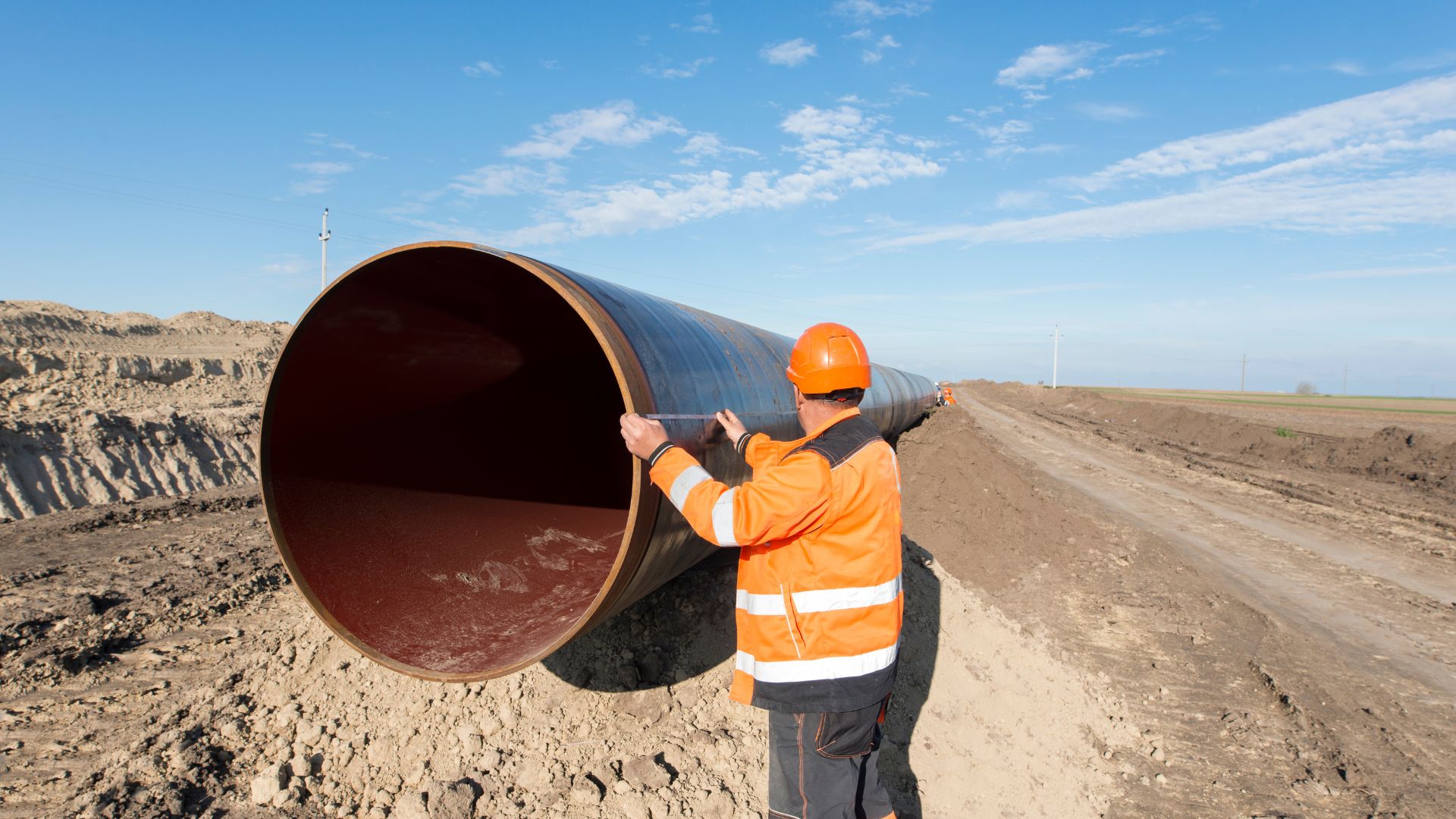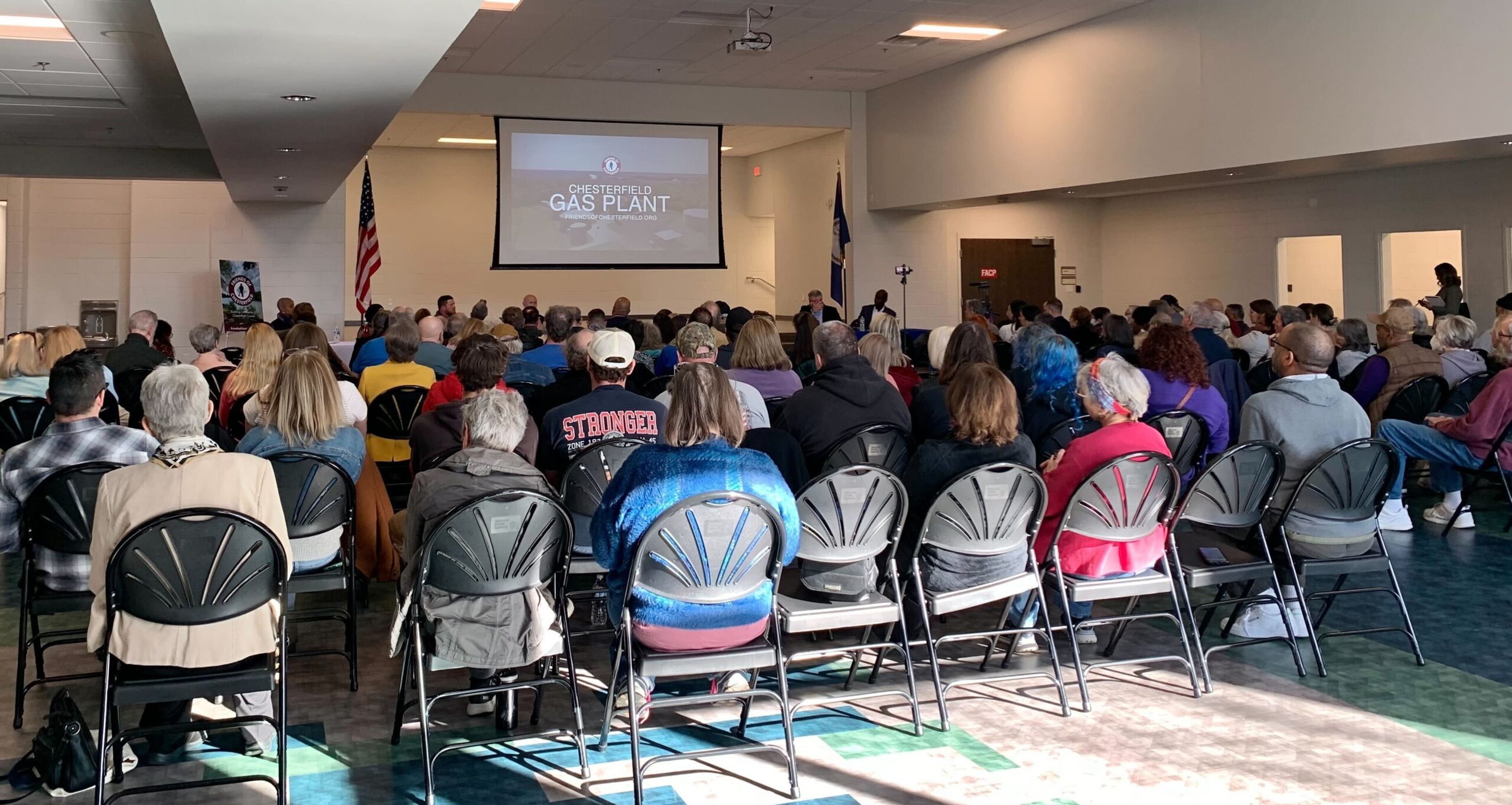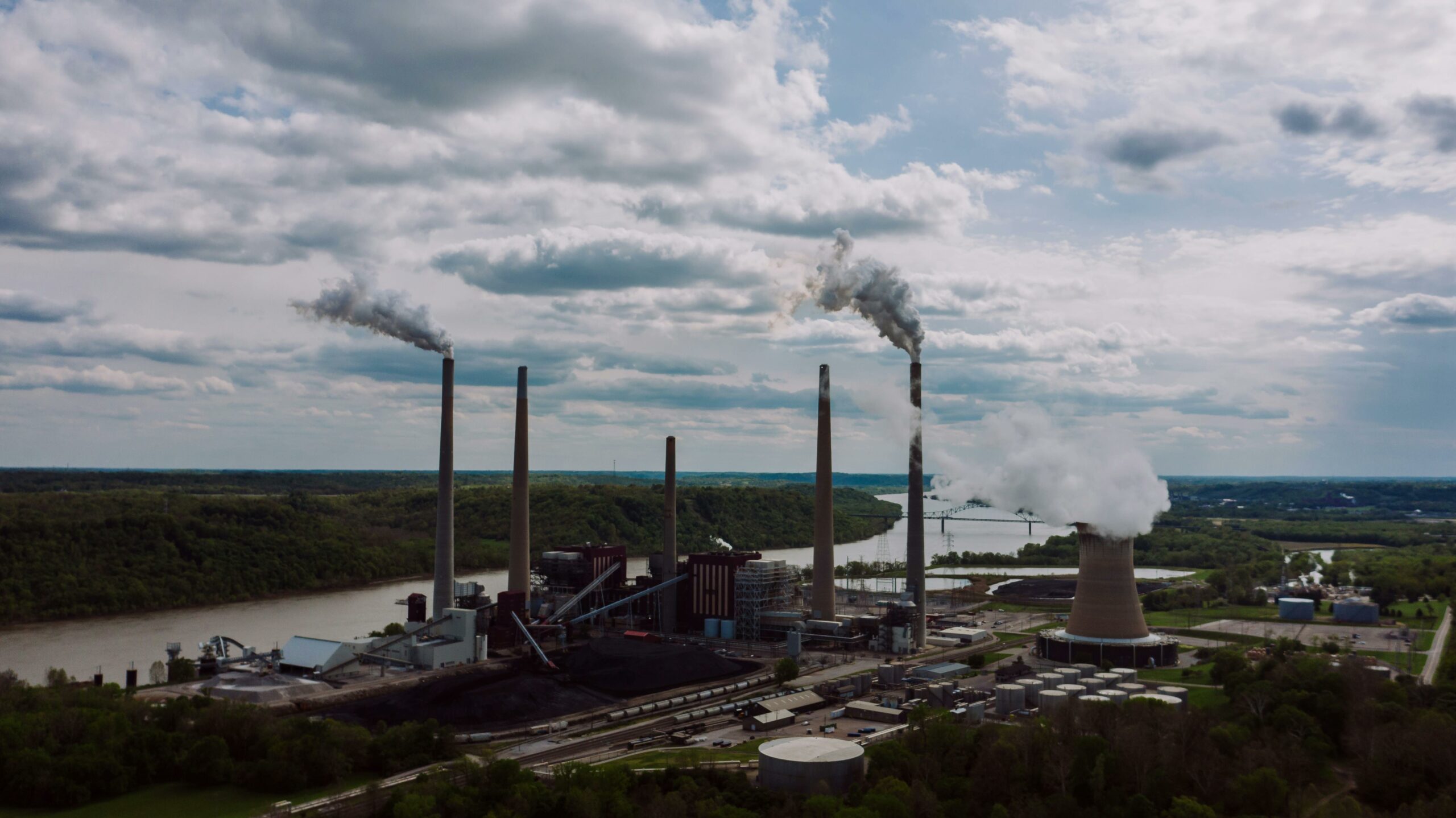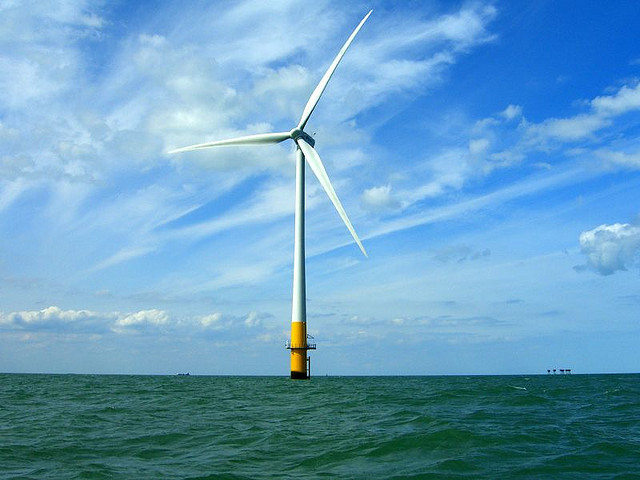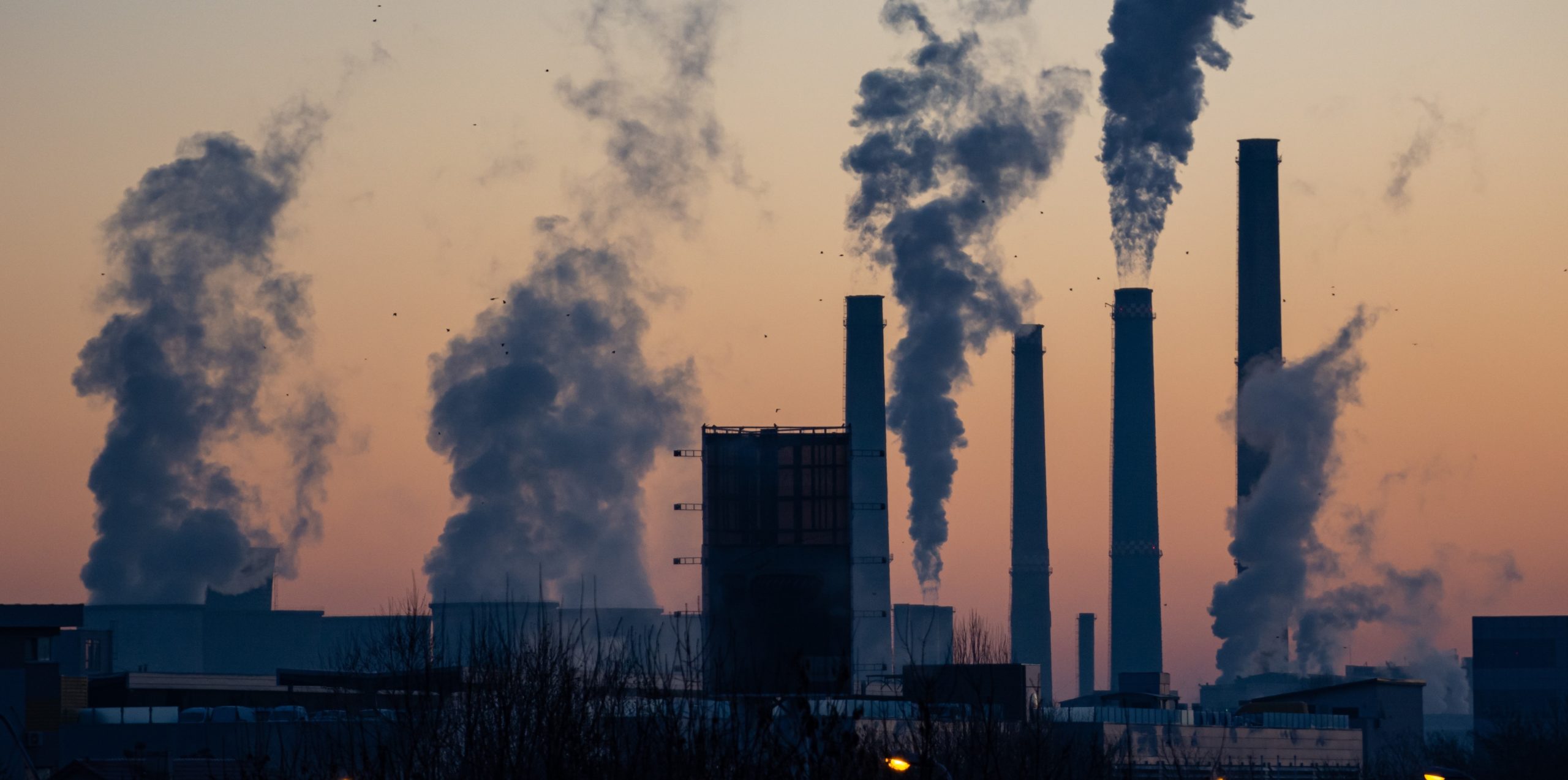Climate advocates are calling for the Federal Energy Regulatory Commission to stop the construction of this expensive and unneeded augmentation to the Transco pipeline.
Continue readingChesterfield Town Hall Hosted by Sen. Hashmi Spotlights Overwhelming Community Opposition to Controversial New Gas Plant
Over 100 Chesterfield residents and regional activists showed up on Sunday at a town hall — led by Virginia State Senator Ghazala Hashmi (D-10) — to speak out against Dominion Energy’s plan to build a massive methane gas plant near the James River.
Continue readingFeb. 25: Senator Hashmi Hosts Town Hall on Costly and Controversial Gas Plant in Chesterfield
Opposition grows against newly proposed fossil fuel plant, which would be largest of its type in Virginia, accelerating Governor Youngkin’s energy policy reversals and undercutting President Biden’s climate plan.
Continue readingCCAN Polar Bear Plunge for the Climate Sets Record for Biggest Crowd Taking A Dip to “Keep Winter Cold”
After the hottest year on record, over 340 climate activists from across the DMV took the biggest plunge yet, raising awareness and funds to fight climate change.
Continue readingEPA Announces Strong Final Soot Rule Offering More Protection for Communities
CCAN applauds as Biden Administration sets tougher industry standards that could save thousands of lives and billions of dollars
Washington, DC — Yesterday, the U.S. Environmental Protection Agency (EPA) took another bold step to curb carbon pollution with their announcement of a final rule update to the National Ambient Air Quality Standards (NAAQS) for Particulate Matter (PM 2.5), more commonly known as the soot rule. The new rule is EPA’s first change to the annual exposure limit for fine particles in more than a decade.
The EPA’s new soot rule is expected to save an estimated 4,500 lives and deliver $46 billion in health benefits by 2032 by setting an average yearly soot exposure standard of 9 micrograms per cubic meter of air, down sharply from the current threshold of 12 micrograms.
President Joe Biden and EPA Administrator Michael Regan deserve tremendous credit for finalizing a strong soot rule that will save lives and provide cleaner air in our communities, especially communities of color overburdened by deadly particulate matter from power plants.
Statement from Quentin Scott, Federal Director for Chesapeake Climate Action Network (CCAN):
“Nearly one year ago we gathered at EPA headquarters demanding a strong final soot rule. On behalf of CCAN and our members, we applaud President Biden and Administrator Regan for listening and acting on the concerns of more than 150 environmental justice, frontline, faith, and community leaders. We look forward to the EPA finalizing additional pollution rules in the coming weeks and months to further curb pollution from power plants and protect the most vulnerable.”
# # #
Saturday Feb. 10: University of Maryland President to Join Largest-Ever Polar Bear Plunge for the Climate Into the Potomac River at National Harbor
Darryll J. Pines
National Harbor, MD — University of Maryland President Darryll J. Pines will join a record crowd of polar bear plungers on the Potomac River this Saturday to draw attention to climate change. Last year was the hottest year on record by a wide margin! And now climate activists are stepping up their efforts like never before. This Saturday, February 10, Chesapeake Climate Action Network (CCAN) will hold its 19th Annual Polar Bear Plunge dedicated to raising awareness and funds to fight climate change. This year’s event at National Harbor, MD, is expected to bring together more than 300 hardy activists and volunteers, making this CCAN’s biggest plunge to date!
At Saturday’s event, Pines will join climate activists from across the District, Maryland and Virginia (DMV) region in spotlighting the need for climate action. For over 20 years, CCAN has been building a people-powered climate movement and driving transformation to a clean energy future. Just two weeks ago, the Biden administration responded to pressure from CCAN and other climate organizations nationwide by announcing a pause on pending approvals of Liquefied Natural Gas (LNG) exports. That federal effort is just one of many CCAN campaigns planned for 2024 across the DC, Maryland, and Virginia (DMV) region and beyond. The annual Polar Bear Plunge provides funding that is essential to those campaigns – raising more than one-third of individual donations made to CCAN each year. This year’s Plunge goal is $210,000.
For more information about the 2024 CCAN Polar Bear Plunge, see below:
WHAT: 19th Annual “Keep Winter Cold” Polar Bear Plunge. For more information, visit www.keepwintercold.org.
WHEN: Saturday, February 10, 2024, 10 AM EST
-
- 10:00 – 11:00 AM: Arrive and check in at the Capital Canopy! We’ll have action tables, music, games, face painting, warm drinks, and yummy snacks.
-
- 11:00 – 11:40 AM: Pre-Plunge rally featuring our guest speakers and costume contest.
*GREAT PHOTO OP*
-
- 11:40 – 11:50 AM: March to the Plunge point and get ready to Plunge.
-
- 11:50 AM – 12:10 PM: PLUNGE TIME!
*GREAT PHOTO OP*
-
- 12:15 – 2:30 PM: Celebrate at the Capital Canopy with fellow plungers! We’ll have pizza, a hot cocoa bar, and a FREE beer from Denizens Brewery (for Plungers age 21 and over), plus games and music!
WHERE: National Harbor, Oxon Hill, Maryland.
-
- Staging area: National Harbor’s Capital Canopy (on the Pier, near the giant Ferris wheel).
-
- Plunge area: Southpointe Beach
SPEAKERS:
-
- Darryll J. Pines, President, University of Maryland
-
- Andreana Lim, Youth Member of the CCAN NoVa New Leafs
-
- Andres Jimenez and his daughter Emma; CCAN Board Member, Executive Director of Green 2.0; Fairfax Co. Board of Supervisors
-
- Quentin Scott, CCAN Federal Director
SPONSORS:
• Green 2.0
• US Wind
• Neighborhood Sun
• International Brotherhood of Electrical Workers (IBEW)
• MAREC Action
• Evergreen Action
• Rewiring America
• EDF Renewables
Speakers will be available after the rally for interviews. If you would like to coordinate an interview, please contact: KC Chartrand, kc@chesapeakeclimate.org, 240-620-7144; or, Ariel Cassell, ariel@chesapeakeclimate.org, 710-718-6760.
###
Chesapeake Climate Action Network, is the oldest and largest grassroots organization dedicated exclusively to raising awareness about the impacts and solutions associated with climate change in the Chesapeake Bay region. For more than 20 years, CCAN has been at the center of the fight for clean energy and wise climate policy in Maryland, Virginia, Washington, D.C. and beyond.
Offshore Wind Continues to Grow Exponentially on the East Coast
Offshore Wind Continues to Grow Exponentially on the East Coast
Even as individual projects have repositioned themselves in order to get to market, new commercial offshore wind projects are moving ahead and coming online up and down the East Coast.
ANNAPOLIS, MD —On January 2, 2024, Vineyard Wind, the first commercial offshore wind project in Massachusetts, started delivering electricity to the grid. In December of 2023, SouthFork Wind, the first offshore wind project in New York, started selling electricity to the grid. In Virginia, Dominion Energy has offshore wind turbines selling electricity to the grid, and is currently building the nation’s largest offshore wind farm. In Maryland, US Wind is plowing ahead with their plans to build an offshore wind farm and deliver clean electricity to the state.
Up and down the East Coast, offshore wind infrastructure is being built and coming online more than ever before. Offshore wind energy can reduce air pollution, improve health outcomes, create good union jobs, and help the state meet its climate mandates. There has never been a better time for offshore wind in America.
Amid this boom in offshore wind, some individual companies and projects have hit speed bumps. On January 25, Orsted announced that it is repositioning its offshore wind projects Skipjack 1 and 2. Those projects are no longer planning to provide the Offshore Wind Renewable Energy Credits to help Maryland meet its clean energy goals. However, Orsted says that it does still plan to build the offshore wind projects. The company is simply looking for a different mechanism to get to market. This announcement is different from Orsted’s announcement in New Jersey where the projects were canceled entirely.
Jamie DeMarco, Maryland Director at CCAN, stated:
“Anytime a new technology is deployed at scale there will be individual projects that face challenges, but the overall trend in the offshore wind industry in the United States is exponential growth.
“Maryland’s Promoting Offshore Wind Energy Resources (POWER) Act of 2023 provided the Department of General Services the authority to purchase up to 5 million megawatt hours of offshore wind energy. Maryland should make full use of this new authority.”
Contact:
Jamie DeMarco, CCAN, Jamie@chesapeakeclimate.org , 443-845-5601
KC Chartrand, CCAN, kc@chesapeakeclimate.org, 240-620-7144
# # #
The Chesapeake Climate Action Network is dedicated to driving change in public policies at the local, state and national level to address the climate crisis. Through voter education, lobbying, and participation in the electoral process, we seek to advance our country’s leadership in the global movement towards clean energy solutions — focusing our efforts primarily in Maryland, Virginia, and Washington, DC. We know that a vibrant democracy is central to our success so we work to defend democratic integrity wherever we can.
Maryland Grid Can Easily Accommodate Electrification of Building and Transportation Sectors, State Study Concludes
Prominent Climate Groups Praise Study Findings, Optimistic About Electrification
Baltimore, MD — A report commissioned by the Maryland Public Service Commission (PSC) shows that Maryland’s grid is equipped to accommodate high electrification of vehicles and buildings, especially if coupled with achievable gains in energy efficiency and load flexibility.
“The results from this study deliver good news to Marylanders,” said Chris Stix, a volunteer with Sierra Club who participated in the study. “We can achieve Maryland’s goals of reducing greenhouse gas emissions by 60% without overloading the electric grid by widely deploying heat pumps. For space and hot water heating, the use of heat pumps is much more efficient than existing electric and fossil fuel appliances. As a result, they contribute only modestly to peak electric loads.”
The study shows that electrification of buildings and vehicles will result in very limited additional load growth relative to what the utilities are already planning in their own growth forecasts over the next ten years. In the high electrification scenario that assumes best-in-class technology (such as highly efficient cold-climate heat pumps), the Maryland system would see 1.1% annual load growth. This load growth could be even further reduced to 0.3% with ambitious but achievable energy efficiency and load flexibility measures.
“All Marylanders deserve a healthy and safe place to live. This study shows that not only can we upgrade homes across the state with clean, highly efficient equipment that will slash pollution and improve public health, but we already have the grid capacity to make those updates,” said Ruth Ann Norton, President & CEO of the Green & Healthy Homes Initiative. “Our state leaders in the General Assembly and Governor Moore must now pursue policies that will equitably deliver healthy, pollution-free homes.”
The expected load growth is comparable to or less than the Maryland system has seen year-by-year over the past 40 years. Historically, the system experienced significant load growth in the 1980s of 4.9% per year and more moderate growth of 1.2-1.5% from 1990-2010. Load declined between 2010-2020.
One reason for the limited impact of electrification is that there is existing headroom available on the grid to handle winter and summer peaks in demand. Heat pumps are also far more efficient than fossil-fuel-powered equipment. They provide both heating and cooling and are two to four times more efficient than gas furnaces and use 29% less electricity than the best-performing central air conditioning units.
In 2022, as part of the Climate Solutions Now Act, the Maryland General Assembly considered whether to require electric heating and cooling equipment in all newly constructed buildings in the state. Concerned about the impacts that new construction would have on the grid, legislators directed the PSC to create the Electrification Study Working Group (ESWG) to study the issue.
“This study completely puts to rest the question of whether the grid can handle electrification of new construction,” said Anne Havemann, Deputy Director and General Counsel for the Chesapeake Climate Action Network, who also participated in the ESWG.
The PSC commissioned the Brattle Group to model five scenarios, two of which meet the state’s goal of 60% GHG reduction from 2006 levels by 2031. The first, 3A, employs a high level of cold-climate heat pumps, with 90% of space heating sales in buildings being heat pumps by 2030. The second, 3B, employs a high level of conventional heat pumps by 2030. Water heater sales are assumed to be 90% heat pumps by 2027. For electric vehicles, all scenarios achieve Advanced Clean Cars II (ACC II) and Advanced Clean Trucks (ACT) regulations.
The assumptions used in Brattle’s study were carefully considered by the Electrification Study Work Group and all stakeholders, including the utilities, had the extensive ability to comment on them. As a starting point, Brattle used each electric utility’s 10-year plan. The starting level of heat pump deployment is based on a 2022 survey commissioned by the PSC.
“Maryland is on the cusp of an exciting transition to a 21st-century energy future,” Havemann added. “To manage this transition equitably and responsibly, Maryland must commit to policies such as zero-emissions equipment standards that can accelerate the adoption of highly efficient technologies such as heat pumps and modernizing its grid to ensure all residents reap the health and economic benefits of pollution-free homes. Targeted incentives and new regulations that prioritize equity must be implemented now to achieve the transition to a highly electrified future in a way that doesn’t leave Marylanders behind. This future is achievable and manageable and we encourage the state to commit now.”
# # #
Governor Moore Calls for Spending $1 Billion a Year to Fight Climate Change
Leading regional climate group praises Moore Administration’s unprecedented comprehensive plan to meet the state’s ambitious climate pollution reduction mandate of 60% by 2031, calls on him to lay out how to raise the funds
Baltimore, MD — Maryland Governor Wes Moore recently released the state’s final plan for reducing heat trapping pollution in line with state law. The plan includes specific recommendations for every sector of the economy which, if fully implemented, would reduce climate pollution 60% by 2031 and keep the state on track to eliminate net emissions by 2045.
“Governor Moore has done what no Maryland Governor has done before: put forward a plan to invest $1 billion a year in the clean energy economy to eliminate our net climate pollution,” said Jamie DeMarco, Maryland Director at the Chesapeake Climate Action Network. “Fully implementing the investments and standards recommended in this report will lower energy bills, create good jobs, improve health outcomes, and achieve our pollution reduction mandates.”
Governor Moore proposes funding the new investment through a combination of green revenue bonds, a cap and invest program, a carbon fee, a hazardous substances fee, a clean air toll, and a pollution fee on fuel burning-vehicles. These investments will pay for themselves many times over. The report says that, if fully implemented, this plan “will generate up to $1.2 billion in public health benefits, $2.5 billion in increased personal income, and a net gain of 27,400 jobs between now and 2031 as compared with current policies. Average households will save up to $4,000 annually on energy costs. Air quality and public health outcomes will improve for everyone, especially people living in historically underserved and overburdened communities.”
While the plan lays out potential options for raising the necessary revenue, it falls short of fully embracing a specific plan to generate the needed $1 billion. “It is Governor Moore’s responsibility to lead on the question of revenue raising, and not punt the hard choices to the legislature,” DeMarco added. “We also expect that the Governor will incorporate equity into every part of the state’s decarbonization process.”
In addition to calling for necessary investments, the plan also lays out the standards and policies needed. It calls for a Zero-Emission Heating Equipment Standard, a 20% reduction in Vehicle Miles Traveled, eliminating trash incineration from the state’s Renewable Portfolio Standard, 100% clean energy by 2035, and more. Each of these policies represents a tremendous victory for Maryland’s climate and communities. Taken together, they form the first ever comprehensive plan that, if fully funded, will reduce climate pollution at the necessary speed.
Previously: Over 40 Maryland Groups Tell Governor Moore to “Get it Done by ‘31” for the Climate
The Chesapeake Climate Action Network, the oldest and largest grassroots organization dedicated exclusively to raising awareness about the impacts and solutions associated with climate change in the Chesapeake Bay region. For 20 years, CCAN has been at the center of the fight for clean energy and wise climate policy in Maryland, Virginia, and Washington, D.C.
VA State Corporation Commission Hearing Examiner Calls for Rejection of Dominion’s Energy Plan
Report corroborates what activists and residents have been saying all along… Dominion does not need to build new fossil-fuel plants to meet demand.
RICHMOND, VA —On December 8, the Virginia State Corporation Commission (SCC) Hearing Examiner recommended the state agency reject Dominion Energy’s energy plan known as the Integrated Resource Plan (IRP). Senior Hearing Examiner A. Ann Berkebile stated that she does “not recommend the Commission find the 2023 IRP to be reasonable and in the public interest.”
Victoria Higgins, Virginia director of the Chesapeake Climate Action Network, stated:
“The Hearing Examiner’s report corroborates what the environmental community and residents around the proposed methane gas plant in Chesterfield have been saying all along: there is no evidence to suggest that Dominion must build new fossil fuel plants to meet demand.
“On top of that, the report underscores how Dominion has utterly failed to plan for an energy future that ensures environmental justice for all.
“Finally, the report also notes that it is incumbent upon Dominion to account for the extraordinary health and economic costs we bear as a Virginia community when the company continues to build and use polluting infrastructure. It is self-evidently unreasonable and against the public interest to double down on fossil fuels with just six years left to cut U.S. emissions in half.”
The news comes shortly after CCAN’s advocacy arm, the CCAN Action Fund, commissioned a report from Gabel Associates finding that Dominion’s proposed plan to build new fossil fuel plants imposes enormous economic and social risks on Virginians, and that Dominion can meet electricity demand with clean energy instead. Read the report here.
It also comes amid months of opposition to Dominion’s proposal to build a massive new methane gas plant in Chesterfield, which is in line with the utility’s fossil fuel-friendly plan and Governor Glenn Youngkin’s 2022 Energy Plan. The proposal is not in line, however, with Virginia’s state law to phase out fossil fuels per the Virginia Clean Economy Act.
Contact:
Victoria Higgins, Virginia Director, vhiggins@chesapeakeclimate.org, 201-937-7017
KC Chartrand, Communications Director, kc@chesapeakeclimate.org, 240-620-7144
# # #
The Chesapeake Climate Action Network, the oldest and largest grassroots organization dedicated exclusively to raising awareness about the impacts and solutions associated with climate change in the Chesapeake Bay region. For 20 years, CCAN has been at the center of the fight for clean energy and wise climate policy in Maryland, Virginia, West Virginia, and Washington, D.C.

